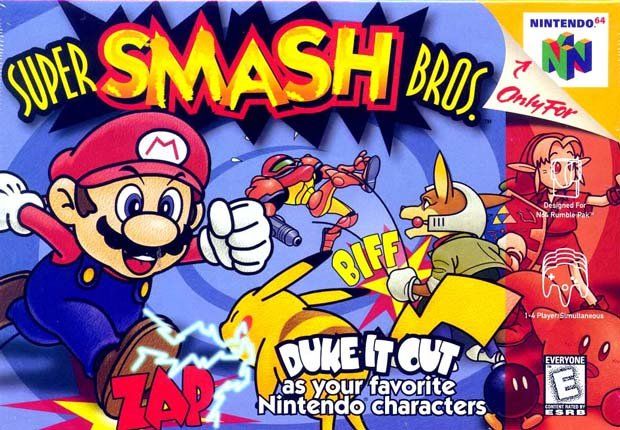
Released for the N64, Super Smash Bros (1999) is truly exceptional. Conceptually and mechanically it’s sick, go and play it.
If this piece serves to impress one message, that was it. I’m privileged to discuss Smash’s innovative premise, rewarding gameplay, and enduring legacy, however it’d be a lot easier if you just trust me and play it. Contemporary audiences take the Smash series for granted. While later instalments refined the gameplay and graphics with an unerring precision, it’d be a shame to allow its original title to fall into obscurity.
While perhaps less appealing than its contemporary descendants, Super Smash Bros. is a remarkable starting point. The concept of a fighting game, saturated with some of gaming’s most recognisable icons, is equally childish and genius. Canonically, the game establishes a vague narrative to justify this premise, however I am yet to meet someone genuinely concerned with this internal reasoning. Profiting from established legacies and relationships, familiar protagonists such as Mario, Link, and Samus maintain much of their personalities, while being given a licence to beat each other to a pulp. While the starting roster screams Nintendo, additional unlockable characters add more diversity, hinting at the bizarre obscurity the series would later delve into. Who even is Captain Falcon anyway? Regardless, this premise would be enough to sustain a lesser game, however Smash offers more than novelty and nostalgia.
In a departure from established fighting games, Smash replaces health bars with damage meters, tasking the player to send their opponents flying off the screen. The more damage you’ve sustained, the easier you are to KO. It’s fairly intuitive. This mechanic truly comes into its own alongside the game’s dynamic, wildly unpredictable stages. From the Pokémon of Saffron City to the acid lake of Zebes, this ensures that Smash avoids the stagnated pace of its contemporary fighting games. While these stages frequently dictate the pace of a given match, this is admirably done without ever feeling like a hindrance, instead placing a larger emphasis on aerial and traversal skills.
Admittedly, Smash’s contemporary appeal has been dampened by the polish of its later instalments. The gameplay, while by no means bad, does struggle in comparison, while its shallow single player also suffers from linearity and predictability, two elements which would later be addressed and enhanced. To spend any amount of time critiquing the game’s graphics would be to miss the point entirely, however it’s fair to say that it doesn’t necessarily break any ground in that department. Where the game truly shines is in its multiplayer.
I love Super Smash Bros because it recalls a simpler era, one before the death of couch multiplayer. Back when you could play games sitting beside your mates rather than having to yell down a mic at them. I don’t believe that modern online multiplayer could ever act as a true replacement for this experience. Of course, the debate of online gaming versus local multiplayer is a nuanced one that I’d frankly prefer to avoid. However, I will say that nothing can beat the genuine interaction of getting together with friends, no matter what the modern gaming industry may tell us. And I’m prepared to die on that hill. Cutting to the core of why many of us originally got into gaming, the death of couch multiplayer is a loss of one of gaming’s strongest pillars. Nintendo has always appreciated this, most recently releasing the Switch and its detachable controllers, reminiscent of that bygone era of normal human interaction. However, this philosophy was obvious as far back as Super Smash Bros. and before.
Forgoing the complicated button combinations of titles like Street Fighter and Tekken, Smash favours accessibility to the point where comparisons to traditional fighting games are virtually redundant. Using the same basic two-button scheme throughout the roster, virtually anyone can pick the game up and give it a go. However, that’s not to say that the game doesn’t have a high skill bar, it absolutely does. Depth isn’t sacrificed for simplicity, a fact illustrated by the incredibly talented and passionate community that has formed around this series.
To address the nostalgic elephant in the room, I am perhaps moderately biased in my evaluation of Super Smash Bros. There’s something about certain characters’ move-sets and stages that just remind me of an older, dare I say more enjoyable, era of gaming. This is without even mentioning the soundtrack and marketing, both of which managed to combine a truly eclectic mix of whimsy and drama, a trend which would persist throughout the series. From the euphoria of Super Smash Bros. Brawl’s (2008) Main Theme to the humour of the original game’s commercial, this series is phenomenal in so many aspects. And this all started in 1999, with the original Smash. Its minor flaws and fallibilities aside, this revolutionary starting point established a foundation for a lineage and legacy, while remaining fun, social, and focused. Reflected in the series’ enduring popularity, over 20 years later, that is success and that is Smash.

I loved your point about couch gaming—while online multiplayer is definitely convenient (and necessary, for some PC games), there’s something about the days of LAN parties and couch games that we lose when we take the easier route. Even disregarding the bad network coding of modern Smash that ruins the online multiplayer for many, there’s a certain social aspect that gets lost there in the translation. There’s nothing quite like sitting side by side with each other in the periphery, sharing the space, and turning to each other between games to celebrate or chat or complain.